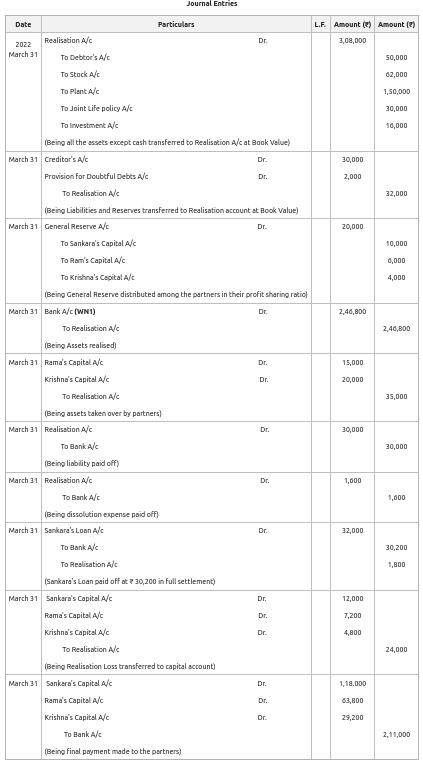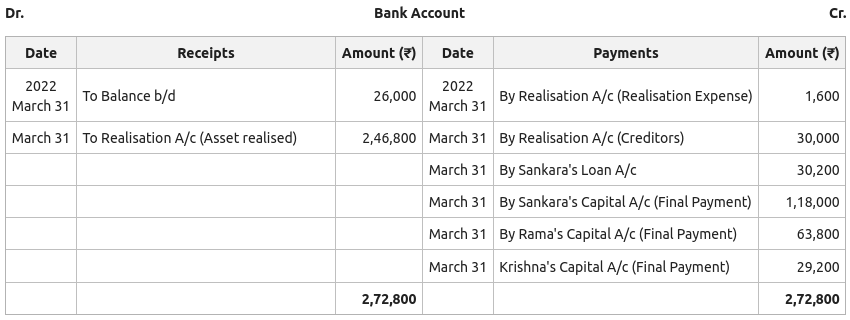Accounting Treatment of Joint Life Policy in case of Dissolution of a Firm – GeeksforGeeks
What is Joint Life Policy?
Joint Life Policy is a life policy that gives coverage against the death of the policyholder, under which the coverage is of a minimum of two persons and the pay-out is on a first-death basis. Since the Partnership firm is a business run by at least two people, the partners may hold the Joint Life Policy in order to reduce the burden of paying a considerably large amount in the event of retirement or death of the partner or Dissolution of the partnership. If any partner dies before the maturity date of the policy, the other partners are eligible to receive the policy amount (Full Claim).
Accounting Treatment:
Case 1: If Joint Life Policy appears in the Balance Sheet:
When a Joint Life Policy appears in the Balance Sheet, it is transferred to the Realisation Account’s debit side, like any other asset at its book value.
Illustration:
Sankara, Rama, and Krishna were partners for 5:3:2 in a firm. Their Balance Sheet on 31st March 2022 stood as:

The partners decide to dissolve the firm on the same date under the followings conditions:
- The Investments are taken over by Rama at ₹ 15,000.
- Joint Life Policy was surrendered for ₹ 20,000.
- The plant was sold for ₹ 1,27,200.
- The stock was sold for ₹ 84,000.
- Krishna took over debtors worth ₹ 24,000 for 20,000. The remaining debtors were realised at 60% of the book value.
- Sankara’s Loan was cleared by paying ₹ 30,200 in full settlement.
- Dissolution expenses cost ₹ 1,600.
Pass necessary Journal Entries and prepare necessary accounts to close the books of the firm.
Solution:





Working Note:
1. Value of Asset Realised:
Joint Life Policy – 20,000
Stock – 84,000
Plant – 1,27,200
Debtors –![]()
Total – 2,46,800
Case 2: If Joint Life Policy reserves also appear in the Balance Sheet:
Under this case, the Joint Life Policy reserves are transferred to the credit side of the Realisation Account.
Illustration:
Lal and Bahadur were partners sharing profit in the ratio of 3:2. On 31st March 2020, they decided to end the partnership and proceed towards dissolution. On the same date, their Balance Sheet stood as:

Additional Information:
- The land is sold at 20% profit.
- Investment is realised at book value.
- Stock is realised at ₹ 30,000.
- All the liabilities including the partner loan are paid off.
- Dissolution Expenses amounted to ₹ 800.
Pass necessary Journal Entries and prepare necessary accounts to close the books of the firm.
Solution:





Case 3: Amount received from the Insurance Company on surrender of the policy:
Under this situation, whatever amount is received from the Insurance Company on the surrender of the policy, is credited to the Realisation Account.
Illustration:
The Balance Sheet of Rahul, Ravi and Raman on 31st March, 2018 stood as:

Additional Information:
- Debtors realised at ₹ 16,800 and Creditors and Bill Payable was paid at a discount of 10%. Short-term Loan paid.
- Stock was taken over by Raman for ₹ 9,000 and furniture was sold for ₹ 7,200.
- Land and Building were sold for ₹ 1,68,000.
- Unrecorded asset worth ₹ 12,000 was realised at ₹ 8,400.
- The firm had a Joint Life Policy of ₹ 3,00,000 with a surrender value of ₹ 51,600. The policy was surrendered at the same value.
Pass necessary Journal Entries and prepare necessary accounts to close the books of the firm.
Solution:





Working Note:
1. Value of Asset Realised:
Joint Life Policy – 51,600
Land and Building – 1,68,000
Debtors – 16,800
Furniture – 7,200
Unrecorded Asset – 8,400
Total – 2,52,200
2. Value of Liablities Paid off:
Creditors – ![]()
Bills payable – ![]()
Short-term Loan – 7,200
Total – 39,600
Stay connected with us on social media platform for instant update click here to join our Twitter, & Facebook We are now on Telegram. Click here to join our channel (@TechiUpdate) and stay updated with the latest Technology headlines. For all the latest Technology News Click Here
